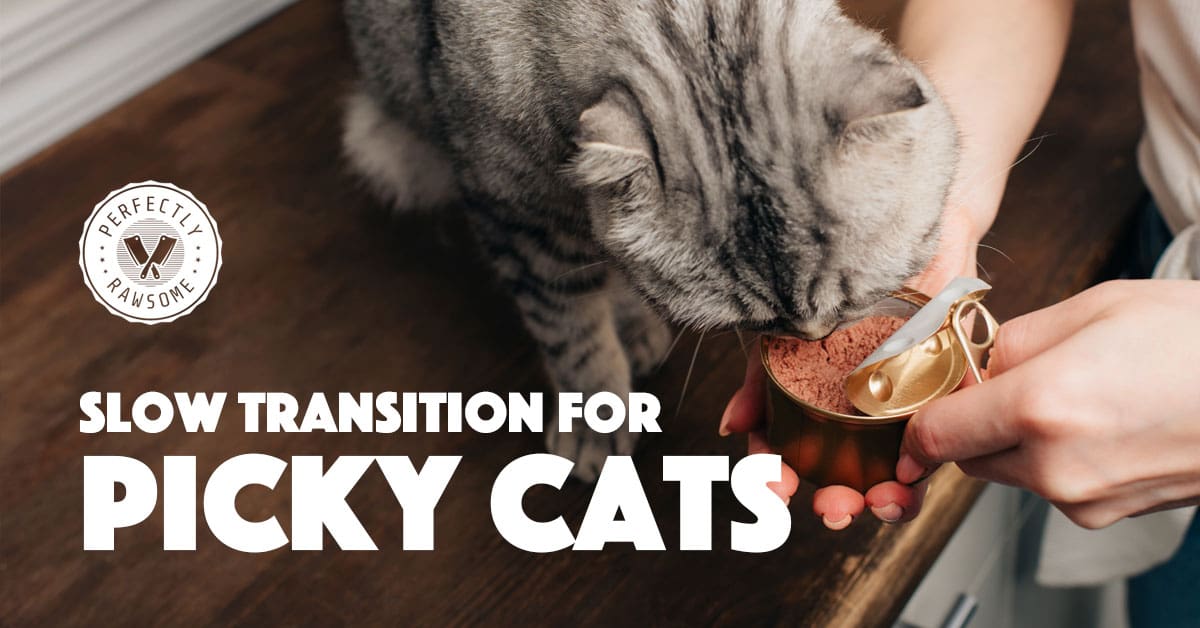Cats are cautious animals by nature and may not take to raw as quickly as dogs. If a cat does not take to raw meals immediately, it is necessary to do a slow transition into a raw diet. This process takes time and patience to wean picky cats off of their previous commercial dry or wet diet.
Cats can be tricky to transition foods due to their food imprinting behavior. This natural behavior makes it difficult for a cat to recognize new foods as “safe” to consume. Imprinting behavior happens over time, therefore it is best to rotate foods as frequently as possible to prevent a cat from becoming imprinted on a single food source.
When transitioning from processed cat food to fresh raw food – cats may not recognize the raw food as safe to consume and therefore will not eat it. However, cats should not go without food for over 24 hours. If transitioning foods is proving difficult due to imprinting behavior, a very slow transition approach is highly recommended.
Create A Feeding Schedule
Begin feeding 3-4 meals at scheduled times versus allowing access to food 24/7.
Transition From Dry Food to Wet Food
If the cat is currently eating dry cat food, begin switching to a canned wet food.
Introduce Small Raw Meat Chunks
Add small cuts of lean meat to the canned wet food to introduce the new food source.
Increase Meat Chunk Size
Increase the size of the meat chunks once the cat is eating small pieces of meat.
Begin Step 1 of the Raw Transition
Once the cat is accepting raw meat, begin step 1 of the raw feeding transition.

Create a Feeding Schedule
If a cat is accustomed to “free feeding” throughout the day, it will be helpful to adjust them to eating on a set schedule before attempting to switch foods. Free feeding is not advisable when raw feeding due to bacteria growth. Therefore, taking this additional step in the beginning will make the transition to raw feeding a little easier.
Select feeding times for each meal and only offer the meal for limited amounts of time (30 minutes). This allows the cat to have times of rest in between meals. Additionally, the sensation of hunger preceding meals will encourage a greater willingness to try new foods. Feeding on a schedule will allow the cat’s body to regulate and begin producing the appropriate gastric acid that is essential for raw digestion.
Transition from Dry Food to Canned Wet Food

Step Two of the slow transition is getting the cat to accept and eat wet meals. Substituting portions of the dry food diet with canned wet food will slowly transition the cat into eating 100% wet foods. Ideally select a chunked style canned wet food rather than a canned paste.
75% Dry Food + 25% Canned Food
Initially, substitute a small amount of dry food with canned wet food mixed in. Begin using 25% canned wet cat food mixed into dry food for the first few days.
50% Dry Food + 50% Canned Food
Once the initial substitution of 25% wet food is accepted, begin increasing the substitution amount. Substitute 50% dry food with wet food.
25% Dry Food + 75% Canned Food
When the cat is accepting 50/50 dry and wet meals, continue to increase the substitution of wet food. Begin substituting 75% of the cat’s dry food with wet food.
100% Canned Food
Once the cat has acclimated to 25/75 dry and wet food, begin feeding 100% wet food. When the cat is eating 100% wet food, move to step three.
Dry Cat Food to Canned Food Transition Speed
Some cats will not take long to transition, while others may be more difficult. Remember to move at the cat's pace and do not allow them to go without eating for more than 24-hours. If the cat is not accepting the changes in food, lower the substitution amount until they accept the meal.
Introduce Small Raw Chunks
Next, begin cutting boneless muscle meat into small, bite sized pieces to add into the canned wet food meals. Use small pieces that can be easily hidden in the chunked canned wet food. This will help disguise the raw meat pieces within the wet food.
3-4 Bite Size Raw Meat Chunks
Mix in small raw chunks into the canned wet food. Be sure to coat the raw food thoroughly with the canned wet food to encourage the cat to eat it.
Increase to 6-8 Raw Meat Chunks
Once your cat is accepting meals with small raw chunks mixed in, it is time to increase the amount of raw included in the meal.
Continue Adding More Raw Meat Chunks
Continue to increase the amount of small raw chunks in the canned food mix. As you begin to include more raw, be sure to decrease the amount of canned food accordingly.
Increase Chunked Raw
Once the cat is eating 50% canned wet food and 50% small raw chunks, start gradually increasing the size of the chunked raw pieces. Begin cutting the muscle meat in slightly larger portions. At this step, it is necessary to continue phasing out the wet canned food accordingly.
50% Canned Food + 50% Raw Meat
When including slightly larger raw chunks, continue with 50/50 for some time to ensure the cat will not refuse the changes.
Increase Raw Chunk Size
Once the cat is consistently accepting larger chunks, continue to increase the chunk size and decrease the canned wet food.
Prepare For The Full Swich
Once a cat is eating primarily chunked muscle meat with small amounts of canned wet food, it is time to take the next step into fully balanced 100% raw meals.
Methods To Encourage
Sometimes all it takes is adding something extra special to encourage the pickiest eaters to eat raw: Nutritional Yeast, Canned Sardine Juice, Bone Broth, Kefir, etc. are several tasty options
CLOSING COMMENTS
While imprinting behavior can make transitioning cats to fresh food difficult, a slow transition approach can help teach cats to accept new foods. The slow transition from dry cat food to raw food is broken down in multiple steps:
Create A Feeding Schedule
Begin feeding 3-4 scheduled meals a day versus allowing access to food 24/7.
Transition From Dry Food to Wet Food
Slowly switch to a canned wet food if the cat is currently eating dry cat food.
Introduce Small Raw Meat Chunks
Add small pieces of lean meat to the canned wet food to introduce the new food source.
Increase Meat Chunk Size
Increase the size of the meat pieces once the cat is eating small pieces of meat.
Begin Step 1 of the Raw Transition
Once the cat is accepting raw meat, begin step 1 of the raw feeding transition.
Once a cat is accepting raw meat in their canned food, it is time to begin step 1 of the raw feeding transition.
